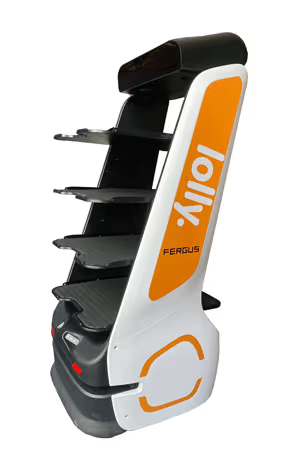Book a Demo
Please fill in the form, and we'll get back to you promptly with the information you need.
Robot Waiters: The Future Of Foodservice Hospitality

Introduction to Robot Waiters
The concept of a 'Robot Waiter' has emerged as a revolutionary development in the restaurant industry, addressing various challenges and opportunities. This article delves into the multifaceted aspects of robot waiters, examining the many benefits that automation brings to the workplace; less dependence on human labour, elevated customer experiences, optimised daily operations, and more.
The Rise of Robot Waiters
The application of robot waiters in restaurants is gradually catching the attention of business owners and customers across the hospitality industry, and thanks to their versatility, they can be deployed in any foodservice environment, from quick-service restaurants (QSRs) to formal dining establishments. For instance, the LollyNova, Lolly’s fully automated robot waiter, is capable of swiftly delivering meals to customers and collecting their food waste, improving processes and increasing speed of operations.
Robot waiters are not a one-size-fits-all solution; rather, they come in a variety of forms and with differing capabilities. Some are designed specifically for navigating complex layouts, while others focus on carrying heavier loads or integrating seamlessly with existing POS and kitchen management systems. Whether it’s bustling city eateries or smaller neighbourhood cafés, robot waiters can adapt to unique operational needs, helping businesses stay agile and competitive.
Benefits of Robot Waiters in Restaurants
Although robots are progressively becoming more normalised throughout the hospitality sector, one of the biggest concerns around robots working in restaurants stems from misconceptions on the technology itself, leaving people asking “will robots take human jobs?” While this is a common assumption, in actuality, robots that operate in these settings are intended by design to work harmoniously with human waiters, which is advantageous in maintaining prompt, efficient levels of table service.
How Robot Waiters Complement Human Staff
Service robots are not a replacement for the human touch, but rather an extension of the team. Their primary role is to handle repetitive and labour-intensive tasks, such as delivering dishes, clearing tables, or transporting food from the kitchen, freeing up human staff to focus on aspects that require empathy, creativity, and personal attention. This division of labour creates a more balanced workflow and helps reduce staff burnout, especially during peak hours.
By taking over the more physically demanding or routine responsibilities, robot waiters allow restaurants to operate more efficiently, even when faced with staff shortages. This collaboration ensures that customer service remains attentive and personable, while the back-end operations become faster and more reliable.
Ultimately, integrating robot waiters into the hospitality environment is not about replacing jobs, but about elevating the overall dining experience for both customers and staff.

Robot waiters excel in quick and efficient food and drink delivery, as well as post-service clean-up, surpassing human capabilities. Along with providing convenient food and drink transportation, robot waiters also help speed up the entire ordering process that occurs when a customer places an order to the kitchen. When an order has been processed and prepared back of house, the robot executes the final delivery step of the customer ordering journey, allowing other members of staff to remain focused on preparing the next line of orders. Additionally, when an order is ready for service, a member of staff simply programs the robot to deliver the order directly to the assigned table. Additional visits to the same table are just as easily configurable for post-service clean-up.
Robot waiters are also programmed with responsive manoeuvring technology, which is achieved through built-in omnidirectional obstacle sensing and high positioning accuracy. This means robot waiters are completely aware of their surroundings, ensuring their functionality is not restricted within catering spaces that are prone to drawing in high footfall.
Furthermore, the integration of robot waiters into restaurant teams can be tailored to support specific business goals. Whether it’s reducing wait times, improving table turnover, or enhancing the overall guest experience, service robots are flexible tools that can complement human staff, not replace them. As the technology continues to evolve, expect to see even greater customisation and integration options, opening new avenues for innovation in the foodservice industry.
Why Invest In Robot Waiters

To help businesses in hospitality thrive, deploying robot waiters will offer greater focus towards redeploying human staff across other areas of the business, allowing team members to naturally flourish when dealing with meaningful day-to-day customer interactions, honing in on providing next-level customer service that is above and beyond expectation. Utilising robot waiters and human staff with the right strategy can help increase customer retention and therefore revenue as the business’ loyalty base grows.
In addition to their ability to complement human staff, robot waiters can be seamlessly integrated into various service models, from casual eateries to upscale restaurants. Their flexibility makes them suitable for a range of environments, whether navigating busy QSRs or gliding through fine dining spaces. Thanks to advanced navigation systems, they can adapt their routes in real time, efficiently avoiding obstacles and people, and maintaining consistent service even during peak hours.
Investing in robot waiters can significantly reduce staff overheads and enable extended business hours without affecting employee welfare. Robot waiters also offer strategic workforce expansion by minimising reliance on staff commutes, insurance, and other factors that do not apply to robotic staff. By taking on repetitive or physically demanding tasks, robot waiters help alleviate the workload for human employees, allowing them to focus on more complex and rewarding aspects of service.
Robot Waiters Driving New Customer Interactions
With the rise of new technologies throughout the hospitality industry, there are now an abundance of methods that customers can choose to place their orders across a range of devices, such as EPoS digital tills, mobile apps and self-serve kiosks and with an increase in demand for robot waiters, a new method of foodservice ordering is quickly developing. Depending on the robot waiter’s capabilities which vary from model to model, customers can either send their orders straight to the kitchen via the robot’s built-in ordering system, or by simply scanning a QR code and/or following on-screen instructions to place their order and pay directly from their table.
As robot waiters are becoming more widely recognised and associated with the future of hospitality, this new technology is creating more options for customers to communicate their orders, and with the additional convenience this method of ordering offers, more memorable experiences and positive feedback will be made from both customers and staff within foodservice establishments.
Pros and Cons of Robot Waiters
Due to the versatile functionality of robot waiters, they can be uniquely tailored to help meet growing business demands and goals. By incorporating robot food services in restaurants, this helps increase efficiency for staff, automate operations, provide consistent levels of customer satisfaction, and maximise productivity, even in labour-constrained environments.
Other advantages of deploying robots in restaurants is their ability to navigate the space with speed and precision (made possible by their built-in omnidirectional obstacle sensors), smooth manoeuvring mechanics, high positioning accuracy, automatic speed adjustment, simultaneous localisation and mapping technology, smart region speed limit functions, and more.
While robot waiter technology is beginning to make its mark on the hospitality industry in other countries, in the UK however, the use of robots in restaurants is highly constitutional to that of a USP for customers, which helps to drive higher footfall and exposure for businesses via their ‘novelty’ factor alone.
Robot waiters are a valuable investment considering the benefits they bring to the hospitality industry. These cost-efficient capabilities include reducing long-term costs and overheads, as hiring a robot waiter is less expensive over time compared to a human staff member. Additionally, robot waiters can extend service hours without incurring extra costs.
While there may be concerns about robots potentially replacing human staff, it's important to note that robot waiters are becoming increasingly normalised within the industry. To stay competitive, businesses must adopt new technologies. Although robot waiters may raise concerns and scepticism, their primary function is to assist human staff, allowing them to focus on providing exceptional customer service and interaction.
Conclusion: Why You Should Probably Explore Further!
In summary, robot waiters offer numerous benefits and applications for businesses. By leveraging their remarkable abilities, they can transform day-to-day operations, increasing efficiency, accuracy, and reliability. This seamless integration with human staff enhances optimisation and delivers exceptional customer experiences and service within foodservice establishments.
Introduce automation across your business with Lolly’s Robot Waiters and unleash your full potential.
Frequently Asked Questions
Related Posts
See all posts
Lolly And Lloyds To Launch Pay By Bank System At Open Banking Expo
Lolly, the UK-based hospitality technology specialist, has collaborated with Lloyds to develop an innovative Pay by Bank system, which will be showcased at the upcoming Open Banking Expo.

Together We Inspire- Lolly x Kids Inspire Partnership
We’re proud to announce our new charity partnership with Kids Inspire, a children's mental health charity offering free trauma support to families who otherwise couldn't afford it.

Natasha's Law, Hospitality Business & Kitchen Management
For food businesses across the UK, food labelling has always been an important part of maintaining trust and safety. But following a tragic incident in 2016, the conversation around allergens became much more urgent.
Subscribe to our Newsletter.
Subscribe to our newsletter to get a curated summary of our latest insights delivered to your inbox monthly. No sales pitches, no spam — ever.


